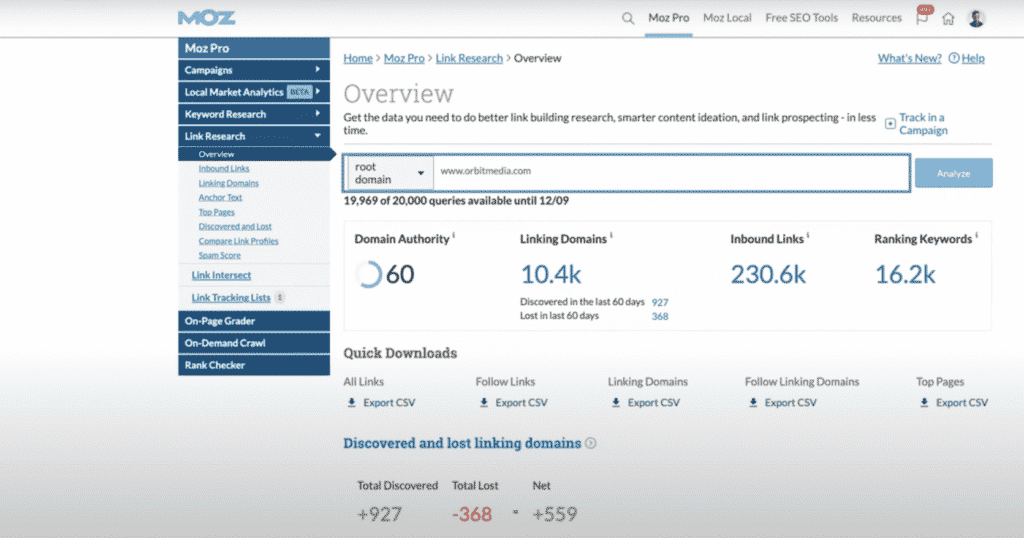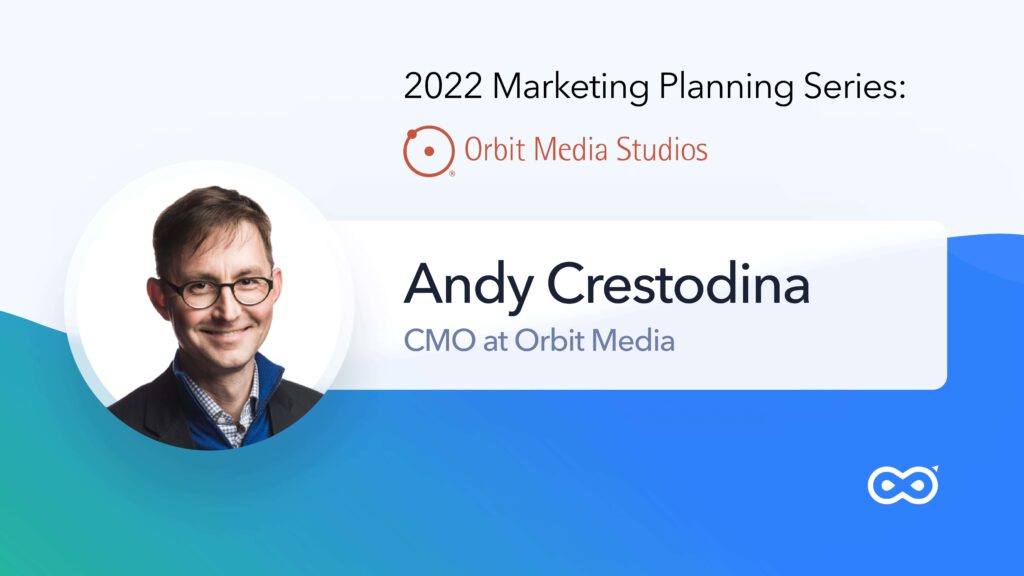Welcome to the second episode of our 2022 Marketing Planning series, where we interview top marketing leaders and dive deep into what their planning process looks like.
We’ll be filling the entire month of December with these valuable interviews (check out our previous interview with Jason Widup of Metadata), so be sure to follow along.
Today, we’re interviewing one of my all-time favorite marketers in the world, Andy Crestodina. Andy is the co-founder and CMO of Orbit Media, an award-winning Chicago-based web design and development company.
Andy shares how he manages long-term marketing programs for his $7M ARR company, with no products and no paid marketing whatsoever. Here are the main planning takeaways from the interview:
- Orbit Media’s marketing consists of several long-term programs. These include an email newsletter, a blog, a bi-weekly webinar, an annual conference, a best-selling book, a LinkedIn newsletter, and various social activities.
- Instead of analyzing the success of each program separately, Orbit Media takes an ecosystem approach. The topics that were raised as questions during a webinar, for example, are later used to generate possible blog posts.
- Orbit Media optimizes its marketing planning by considering missed opportunities. For example, following the success of the LinkedIn newsletter initiative, it is now going to be sent out on a weekly instead of a bi-weekly basis.
- Andy connects content efforts to revenue in the most straightforward way. Orbit Media spends zero dollars on paid marketing, yet the company is able to generate 900 leads a year. His formula is simple: Content > Links > Authority > Ranking for valuable key phrases > Qualified visitors > Leads > Customers.
- Orbit Media’s content helps to accommodate for the long sales cycle. By creating content that is relevant to a specific vertical, Orbit Media is able to re-engage with prospects.
- Orbit Media deals with its long sales cycle by focusing its content efforts on keeping in touch with prospects. For example, by doing extensive research on one of its verticals (banking), it became much easier to reach out to potential banking customers in their CRM.
Orbit Media’s marketing planning process includes several successful long-term programs
Our marketing has evolved to become a series of programs. there is the email newsletter, the blog, the bi-weekly webinar, the annual conference, the book, the LinkedIn newsletter and then there are all kinds of other social activities.
And then we have an account-based marketing program. We look at the performance of these programs, and then decide whether they should be discontinued or whether we should invest more but they should be changed somehow. There are mostly very evolved and refined systems that are built into these programs.
For example, our bi-weekly webinar it’s called ‘Wine and Web’. This was the 11th year we’ve done it. It’s very fast and efficient. It doesn’t take a lot of discussions. We just have to find the next speaker or I teach every other one.

We just decide if there is a way that they should be adapted. It was adapted a year and a half ago. We turned it into a webinar, because we couldn’t do live events and at that moment our planning changed, we decided to make it bi-weekly. The process for follow-up, the value to visitors and attendees as a networking event. the entire thing changed because it became virtual.
For webinars, we measure attendance, as well as anecdotal and qualitative feedback from people. We are also using it to feed topics and speakers to our other channels.
This is the ecosystem philosophy.
For example, I spoke at an event four months ago. They asked me a lot of questions about LinkedIn. People liked two answers I gave which haven’t written about before.
When a webinar is coming up, I’m going to make a ‘Wine on the Web’ about LinkedIn for B2B marketers. It went very well and the feedback was great. I included an influencer, we had about 200 registrants, I knew that this topic was working. Time for the next format, the newsletter. The last newsletter became this big thing like 10 tips for LinkedIn, including the quotes from the influencer, using some of the slides and graphics from the webinar.
These things are all feeding each other, they’re not isolated events. The topics, the collaborations, and the formats are all complementing each other. That was very successful. Tons of great people are still writing to me. “I missed it but I heard it was great can you share the video”.
And we have analytics on it. The performance of the landing page, the click-through rate from the email, the number of registrants, the number of live attendees, and the number of views on the post-event landing page.
This program complements the other programs. It touches on all the important criteria for success:
- It’s collaborative.
- It’s live.
- It creates urgency.
- It complements our other formats.
That’s an event that we’ll just keep doing next year with basically no change. The blog and newsletter — no change.
Orbit Media optimizes its planning through identification of missed opportunities
When planning, we look for missed opportunities. We’ve identified a big missed opportunity that we made that may lead to a structural change.
About a year ago, we pressed the ‘Create Newsletter’ button on LinkedIn. Now, when we publish articles, it will send them to people that have subscribed to that LinkedIn newsletter.

It went from zero to 120,000 subscribers. All it took was a virtual assistant copying and pasting old articles into LinkedIn. Now it has five times the subscribers as our normal newsletter.
This becomes a planning opportunity for 2022. What should we do? We’re doing weekly articles. The newsletter we do is bi-weekly — let’s make this the same article, not just old articles. It’s just another channel for this to promote the same content.
That’s an example of a change in plans because of an opportunity.
Orbit Media’s marketing is 100% organic, making it easier to attribute efforts to revenue
‘Web design Chicago’, I need leads for this every day. We’re a project-based we have no recurring revenue
How do you rank this high for a phrase that valuable?
This phrase is worth, for people that rank, maybe a million dollars a year, maybe much more. We’re a seven million dollar a year company with no advertising. 100% organic growth based on content marketing. How do you rank that high for that phrase? The answer is you have to have a site that has significant enough authority to compete for that phrase. (Here is Orbit Media’s post about it)
Our authority level is 60 (according to Moz). 10,000 websites have linked to us. Why did they do that? Well, it’s because we have relationships with content creators, but we also have content that’s worthy of being linked to.

We produce research articles about topics like web design standards, website navigation, writing headlines, the ideal length for articles. We have lots of content that has lots of links to it, giving us a very high overall domain authority which helps us rank for the very valuable keyphrases.
I honestly have no idea how you could build a lead generation machine that kicks out leads every day. We generated 900 leads last year. There’s a real chance that I’ll generate a lead during this call, but there is just no way of doing that without blog posts.
Orbit Media’s content helps to accommodate for the long sales cycle and makes it easier to reconnect with prospects
We have a very long sales cycle. We sell hundred thousand dollar websites, and it takes people weeks or months sometimes to decide who to hire.
I recently closed a deal that where I’ve been talking to them for a year and a half. What happens after you have the first sales call is that urgency may disappear, or they may just start shopping around looking at competitors.
How do you stay in front of this company? There again content is super useful.
We published some research about what’s good on banking websites. Have I talked to any banks in the last two years? Are there any banks in our pipeline right now? Can I reach out to people and specifically invite them to engage with our content because they are a prospect or they were a prospect.
The sales team is expected to keep following up again and again. I haven’t heard from them in two weeks. Time to call them again. Why? What’s that call sound like? It sounds terrible. It sounds boring. It’s annoying. But if the callback is something that’s engaging:
“Hey, I know you’re not ready for a website now, but we just finished some research about bank websites. If you’d like to join this webinar, you’ll see what banks are doing on their websites.”
That’s a much better call. It’s not account-based marketing but it is content-based vertical-based. You have a reason to follow up. Without content, you have no reason to follow up.
One other powerful idea is to call up people and ask them to be part of the content. “Hey bank that I want you to hire me. I’m writing an article about this, would you like to contribute a quote “
Now you’re including your prospects in your content. That call is a press hit for them, they’re very excited by it. They love that. And do you have time to do that? Yes, because it’s a long sales cycle. That’s when these things are helpful, when the sales cycles are very long.
Summing Up
It’s inspiring to see a 100% content lead organization that manages to be successful for many years without having a paid marketing budget. It requires running tight programs and making sure all the pieces contribute to the bottom line.
We hope you found this episode as inspiring as we did. Stay tuned for upcoming episodes, which include the CMO at Uberflip and former CMO of Drift.

